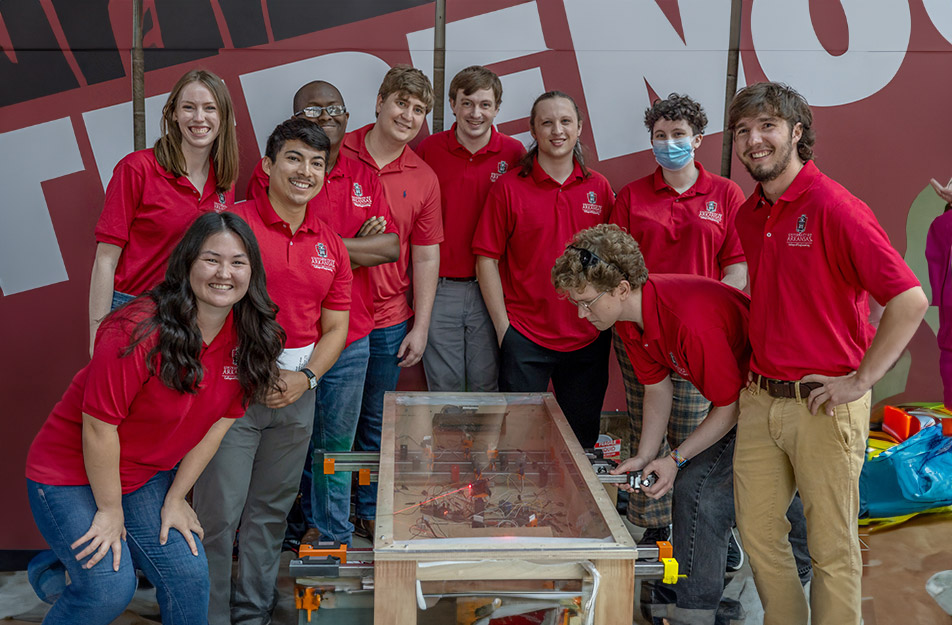Electrical Engineering & Computer Science
In the department of Electrical Engineering and Computer Science, faculty and students are working to improve existing technology and create the next generation of electronics and computing hardware and software.
Degrees Offered
Career Outlook
Our personalized approach not only enhances your skills and knowledge but also ensures
that your education is relevant and fulfilling, positioning you for success in your
engineering career.
What You Can Do
Electrical Engineering
- Embedded System Engineer
- Power Electronics Designer
- Semiconductor Engineer
- Wireless Communication Engineer
Computer Science
- Artificial Intelligence Engineer
- Cyber Security Specialist
- Data Scientist
- Data Engineer
- Data Analyst
- Software Engineer
Computer Engineering
- Computer Hardware Engineer
- Robotics Engineer
- Computer Systems Engineer/Architect
- Satellite Communications Specialist
Industries You Can Work In
Electrical Engineering
- Renewable and clean energy
- Electric vehicles (land, ocean, space)
- Robotics and automation
- Smart phones and communication networks
- Smart Grid
Nanotechnology & optoelectronics
Computer Science
- Healthcare
- E-Commerce
- Energy
- Cybersecurity
- Information Technology
- Financial Services
Computer Engineering
- Hardware Design
- Communications
- Defense
Research Areas
Cybersecurity
- Jia Di
- Kevin Jin
- Qinghua Li
- Alex Nelson
- Brajendra Panda
- Dale Thompson
- Xintao Wu
Big Data, Data Analytics, and Blockchain
- Susan Gauch
- Brajendra Panda
- Xintao Wu
- Lu Zhang
Machine Learning and Quantum Machine Learning
- Khoa Luu
- Alex Nelson
- Thi Hoang Ngan Le
Computer Vision and Image Processing
- John Gauch
- Khoa Luu
- Ukash Nakarmi
- Thi Hoang Ngan Le
Trustworthy and Responsible Artificial Intelligence
- Khoa Luu
- Ukash Nakarmi
- Thi Hoang Ngan Le
- Xintao Wu
- Lu Zhang
Computer System Design and High Performance Computing
- David Andrews
- Jia Di
- Miaoqing Huang
- Kevin Jin
- Alex Nelson
- Yarui Peng
Deep Learning and Natural Language Processing
- Susan Gauch
- Khoa Luu
- Ukash Nakarmi
- Thi Hoang Ngan Le
Algorithmic Self-Assembly and Biomolecular Computing
- Matthew Patitz
Computer-Aided Design
- Yarui Peng
Communications, Digital Signal Processing, and Sensor Networks
- Jingxian Wu
- Junliang Dong
Electronics and Electronic Packaging, Analog and Mixed Signal, and Integrated Circuits
- Zhong Chen
- Alan Mantooth
- Hameed Naseem
- Fisher Yu
- Jeff Dix
- Xiaoqing Song
Power Systems, Power Electronics, Renewable Energy, and Control
- Zhong Chen
- Omar Manasreh
- Alan Mantooth
- Roy McCann
- Hameed Naseem
- Fisher Yu
- Yue Zhao
- Morgan Ware
- Xiaoqing Song
RF and Microwave, Electromagnetics, Antennas, and Terahertz
- Samir El-Ghazaly
- Magda El-Shenawee
- Junliang Dong
Semiconductors, Nanotechnology, Optoelectronics, Photovoltaic, and Photonics
- Zhong Chen
- Samir El-Ghazaly
- Omar Manasreh
- Alan Mantooth
- Roy McCann
- Hameed Naseem
- Fisher Yu
- Morgan Ware
- Junliang Dong
Electrical Engineering Research Labs
- Innovative Nano/Biosensor Lab (INB Lab)
- Mixed-Signal CAD Lab
- Nanomaterials and Nanotube Research Laboratory (NNRL)
- Optoelectronics Research Lab
- Organic Devices and Electronics Lab (ODEL)
- Sustainable Smart Electrical Energy Systems
- Terahertz Imaging and Spectroscopy Computational Electromagnetics Group
- Power Electronic Systems Laboratory at Arkansas (PESLA)
- Power Switch Lab
- Power Systems Control Laboratory
- Intelligent Information Sensing, Processing, and Transmission Laboratory
- ISLAND (Integrated Systems Lab for ANalog Design)
- Photonic Integrated Circuits Lab
- Yu’s Group
- Intelligent Information Processing Lab
- Intelligent Terahertz Laboratory (iTHz-Lab)
Computer Science & Computer Engineering Research Labs
- Applied Embedded Systems and IoT Research Lab (AESIR)
- Artificial Intelligence & Computer Vision (AICV) Lab
- Center for Information Security and Reliability
- Causal AI Lab
- Computer System Design Lab
- Cybersecurity and Privacy Lab
- Energy-Efficient Electronics and Design Automation (E3DA)
- JinLab
- Nakarmi Lab: Computational Imaging and Data Analytics Research
- Resilient Information and Operational Technology (RIOT) Lab
- Social Awareness and Intelligent Learning Lab
- Social Media Research Group
- Trustable Logic Circuit Design Laboratory
Department News

Student Organizations and Clubs
Join to gain experience, enhance your degree, connect with peers, and make a collective impact.
- Association for Computing Machinery
- Institute of Electrical and Electronics Engineers
- CyberHogs
- Girls in Tech
- Trustworthy Machine Learning Reading Group